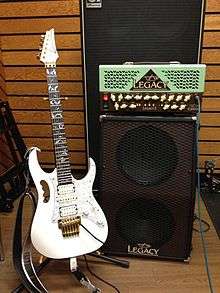Carvin Corporation
| Private | |
| Industry | Amplifiers |
| Genre | Music company |
| Founded | 1946 |
| Founder | Lowell Kiesel |
| Headquarters |
San Diego, California |
Area served | Global |
| Products | Amplifiers, Audio equipment |
| Website |
www |
Carvin Corporation is an American guitar amplifier and audio equipment manufacturer in San Diego, California. It is one of only a few remaining family-owned companies in the industry.[1]
History

Lowell Kiesel founded Carvin in San Diego, California in 1946 as the L. C. Kiesel Company to manufacture guitar pickups. By 1947, the company manufactured steel guitars in Gothenburg, Nebraska. Around 1948, it returned to Southern California—and, in 1949, moved to Baldwin Park, California, where the company name changed to Carvin, after Kiesel's two eldest sons, Carson and Gavin. The company's current production facility occupies 82,000 square feet.[1]
Throughout the 1950s, 1960s, and early 1970s, Carvin manufactured guitars and bass guitars, largely from bodies and necks made by Höfner. During this period, they also manufactured amplifiers and steel guitars, and were authorized resellers of other gear, including Fender and Martin guitars, DeArmond pickups, and Sonola accordions.
In the late 1970s, Carvin began to produce all their own instrument components, and expanded their product lines to include professional audio gear, recording equipment, lighting, and other stage and studio equipment. Later, Carvin switched to manufacturing through-neck guitars, attracting metal players such as Jason Becker.
Starting in the 1970s, Carvin developed a niche in the musical instrument world by only selling directly to the public via mail order, In the 1980s they began to offer guitars and basses built to a customer's specifications, based on available body shapes, woods, colors, electronics, and other features.
In 1991 the company opened showrooms in Southern California that resemble a full-fledged music store, only lacking effects devices, keyboards and drum gear. For a long time since the late 90s the Santa Ana location had a sign of "Forbidden Riffs" posted on the wall (i.e.; no Stairway To Heaven, Enter Sandman, Smoke On the Water etc.)The showrooms are stocked with an impressive selection of production models, many with popular custom options already built into the guitars.
In 2015, Carvin Corporation split off the guitar business to a new company, Kiesel Guitars, which continues to build electric and acoustic guitars, MIDI synth guitars, bass guitars and other instruments under the Carvin Guitars name as well as new, Kiesel-badged instruments. Carvin Corporation continues to operate the brands Carvin Amplifiers and Carvin Audio, which manufacture guitar and bass amplifiers and pro audio gear.[2][3]
Notable users
Current and past Carvin users include: Greg Howe, Jonathan Butler, Frank Zappa, Nicki Kin, Allan Holdsworth, Frank Gambale, Steve Vai, Joey Tafolla, Brendon Small, Bunny Brunel, Craig Chaquico, Alex Lifeson, Jason Becker, Marty Friedman, Al Di Meola, Wolf Mail, Yngwie Malmsteen, Willie Nelson, Danny Elfman, Joe Walsh, Shawn Lane, Tony MacAlpine, Timothy B. Schmit, Candy Coburn, Doug Lindsey, Warren Cuccurullo,[4] Jaco Pastorius,[5] Neil Zaza, John McVie, and Earl Slick.
References
- 1 2 Moseley, Willie G. (June 2009). "The Carvin DN440T". Vintage Guitar. p. 64.
- ↑ Varga, George (January 20, 2015). "Carvin splits in two to launch Kiesel Guitars". Retrieved March 5, 2016.
- ↑ "Carvin Announces the Launch of Kiesel Guitars". January 24, 2015. Retrieved March 5, 2016.
- ↑ http://www.carvinmuseum.com/decade/images/85-endorsers4.html
- ↑ http://www.carvinmuseum.com/decade/images/85-endorsers5.html
- Company profile, Carvin Corporation, Musicians Hotline, July/August 2004, accessed on line March 9, 2007.
- Carvin Turns 60, Michael Molenda, Guitar Player, December 2006, accessed on line March 9, 2007.
- Carvin DN640K, review, Willie G. Moseley, Vintage Guitar, March 2005, accessed on line March 9, 2007.
- Carvin Cobalt C780 Jumbo Acoustic-Electric, review, proaudioreview.com, accessed on line March 9, 2007.
External links
| Wikimedia Commons has media related to Carvin Corporation. |
- Official website
- NAMM Oral History Interview with Lowell Kiesel June 24, 2003
- NAMM Oral History Interview with Carson Kiesel June 24, 2003